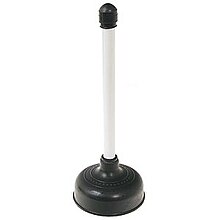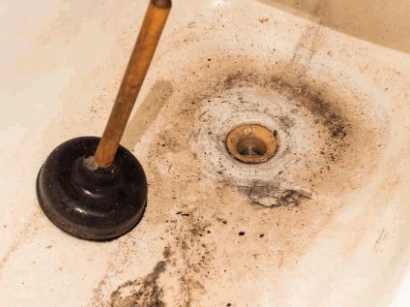Master Plunger and Drain Cleaner: Effective Approaches
Master Plunger and Drain Cleaner: Effective Approaches
Blog Article
What are your opinions on How to Use a Plunger to Unclog a Toilet or Drain?

Intro
Correct upkeep of house drains pipes is necessary for preventing obstructions and making sure smooth water flow. One of the key devices in every homeowner's toolkit is the bettor, together with various drain cleaners created to deal with stubborn obstructions successfully. This post discovers just how to make use of bettors and drainpipe cleansers efficiently to maintain your drains streaming easily.
Section 1: Understanding Plungers
Types of Plungers
There are several sorts of plungers offered, each made for different kinds of drains and blocks. One of the most typical kinds consist of cup plungers, flange plungers, and accordion bettors.
How Plungers Work
Plungers work on the concept of developing stress and suction to dislodge obstructions. When appropriately used over a drainpipe, they develop a vacuum that can pull out particles or break up obstructions.
Choosing the Right Bettor
Selecting the ideal plunger relies on the kind of drain and the nature of the clog. Mug bettors are suitable for sinks and tubs, while flange bettors are much better matched for commodes as a result of their design.
Typical Blunders with Plungers
Preventing these blunders makes certain efficient plunging: inappropriate seal around the drainpipe, insufficient pressure, and unclear bordering debris.
Area 2: Using Plungers Properly
Prep work
Prior to plunging, guarantee the bettor covers the drain completely and develops a limited seal. Clear any type of visible particles around the drainpipe opening.
Technique
Beginning with mild plunging movements to build suction. Rise stress slowly, using a stable rhythm. Repeat as required up until the drainpipe gets rid of.
Repairing Tips
If plunging does not work, try changing the seal, applying petroleum jelly for a better seal, or using a various sort of plunger.
Section 3: Comprehending Drain Cleaning Company
Sorts Of Drainpipe Cleaners
Drain pipes cleansers can be chemical or enzymatic. Chemical cleaners make use of strong chemicals to liquify clogs, while enzymatic cleansers make use of natural enzymes to break down organic matter.
Exactly How Drain Cleansers Work
Chemical cleansers react with obstructions to dissolve them, while enzymatic cleansers break down natural products like hair and grease without damaging pipelines.
Security Considerations
Constantly use handwear covers and eye defense when utilizing chemical drain cleansers. Make sure sufficient air flow and comply with manufacturer guidelines very carefully.
Eco-Friendly Alternatives
Think about making use of vinegar and baking soda or enzyme-based cleansers for eco-friendly alternatives that are safer for pipelines and the atmosphere.
Area 4: Using Drain Cleaners Efficiently
Application Strategies
Pour chemical cleaners straight into the drainpipe opening. Enable them to benefit the recommended time prior to purging with hot water. Enzymatic cleansers should sit over night.
Precautions
Prevent blending various sorts of cleaners, as this can create hazardous fumes. Never ever make use of chemical cleaners along with a plunger, as splashing can happen.
Taking Care Of Persistent Obstructions
For relentless obstructions, take into consideration making use of a pipes serpent or calling an expert plumbing technician to avoid damage to pipes.
Conclusion
Finally, understanding exactly how to make use of bettors and drain cleaners successfully is essential for maintaining healthy and balanced plumbing systems. By picking the right tools and strategies, house owners can tackle small clogs and stop major pipes issues down the line.
How To Properly Use A Plumbing Snake To Clear Drains
When any drain clogs in our home arise, we tend to gravitate toward the plunger and little else. In cases where the plunger and its vacuum-created pressure are not able to clear clogs, many immediately move to harmful chemicals or simply call their plumber to fix the issue.
we’re happy to help with all drain cleaning needs and concerns. This includes informing you on a few other home remedies you may have at your disposal for minor to moderate clogs, one of which is the use of a plumbing snake. Many people have never used one of these before – let’s go over the steps to take when your drain clogs and you have a plumbing snake available.
Attempt Plunger Use
The first step here, as we noted above, should indeed be to grab your plunger when you notice a drain clog and attempt to resolve it this way. If you’re unsure how to use a particular type of plunger, our plumbers can answer any questions you have. If this doesn’t do the trick, however, you move on to the snake.
Locate And Prepare Snake
A plumbing snake is a metal or plastic device that’s generally about a quarter of an inch thick. It’s design with significant extensions, meant to reach down into your clogged drain and push the clog out. Snakes also contain drain augers that will latch onto and push stubborn blockages.
If your plunger doesn’t clear a clog, locate your snake and bring it to the drain in question. We also recommend keeping a bucket nearby to collect the clog once you pull it out, plus we’d advise wearing goggles and possibly protective gloves.
Feed Snake
Once you’re ready to go, feed the snake slowly down the drain, using the crank device it comes with to keep it moving until it finds the clog. Once this happens, much of the clog will be latched onto the coil so you can pull it out, while the rest will simply break up and flow downward.
Detach Debris
Remove the snake slowly from the drain, and once you’ve done so, pick off any debris that’s stuck to the coil. This is another area where wearing gloves is a must.
Flush Drain
Finally, take a few minutes to ensure the snake has done its job correctly. If you’ve been using it on a toilet, flush the toilet a couple times and make sure everything flows well. If you’ve used it on a different drain, flush it with some room temperature water.
https://www.mybuddytheplumber.com/blog/how-to-properly-use-a-plumbing-snake-to-clear-drains/

Application Strategies
Pour chemical cleaners straight into the drainpipe opening. Enable them to benefit the recommended time prior to purging with hot water. Enzymatic cleansers should sit over night.
Precautions
Prevent blending various sorts of cleaners, as this can create hazardous fumes. Never ever make use of chemical cleaners along with a plunger, as splashing can happen.
Taking Care Of Persistent Obstructions
For relentless obstructions, take into consideration making use of a pipes serpent or calling an expert plumbing technician to avoid damage to pipes.
Conclusion
Finally, understanding exactly how to make use of bettors and drain cleaners successfully is essential for maintaining healthy and balanced plumbing systems. By picking the right tools and strategies, house owners can tackle small clogs and stop major pipes issues down the line.
How To Properly Use A Plumbing Snake To Clear Drains
When any drain clogs in our home arise, we tend to gravitate toward the plunger and little else. In cases where the plunger and its vacuum-created pressure are not able to clear clogs, many immediately move to harmful chemicals or simply call their plumber to fix the issue.
we’re happy to help with all drain cleaning needs and concerns. This includes informing you on a few other home remedies you may have at your disposal for minor to moderate clogs, one of which is the use of a plumbing snake. Many people have never used one of these before – let’s go over the steps to take when your drain clogs and you have a plumbing snake available.
Attempt Plunger Use
The first step here, as we noted above, should indeed be to grab your plunger when you notice a drain clog and attempt to resolve it this way. If you’re unsure how to use a particular type of plunger, our plumbers can answer any questions you have. If this doesn’t do the trick, however, you move on to the snake.
Locate And Prepare Snake
A plumbing snake is a metal or plastic device that’s generally about a quarter of an inch thick. It’s design with significant extensions, meant to reach down into your clogged drain and push the clog out. Snakes also contain drain augers that will latch onto and push stubborn blockages.
If your plunger doesn’t clear a clog, locate your snake and bring it to the drain in question. We also recommend keeping a bucket nearby to collect the clog once you pull it out, plus we’d advise wearing goggles and possibly protective gloves.
Feed Snake
Once you’re ready to go, feed the snake slowly down the drain, using the crank device it comes with to keep it moving until it finds the clog. Once this happens, much of the clog will be latched onto the coil so you can pull it out, while the rest will simply break up and flow downward.
Detach Debris
Remove the snake slowly from the drain, and once you’ve done so, pick off any debris that’s stuck to the coil. This is another area where wearing gloves is a must.
Flush Drain
Finally, take a few minutes to ensure the snake has done its job correctly. If you’ve been using it on a toilet, flush the toilet a couple times and make sure everything flows well. If you’ve used it on a different drain, flush it with some room temperature water.
https://www.mybuddytheplumber.com/blog/how-to-properly-use-a-plumbing-snake-to-clear-drains/

I'm just very intrigued by Tips on How to Effectively Use a Plunger and I really hope you appreciated our blog post. Please set aside a second to share this blog posting if you enjoyed it. I appreciate your readership.
Request Appointment Report this page